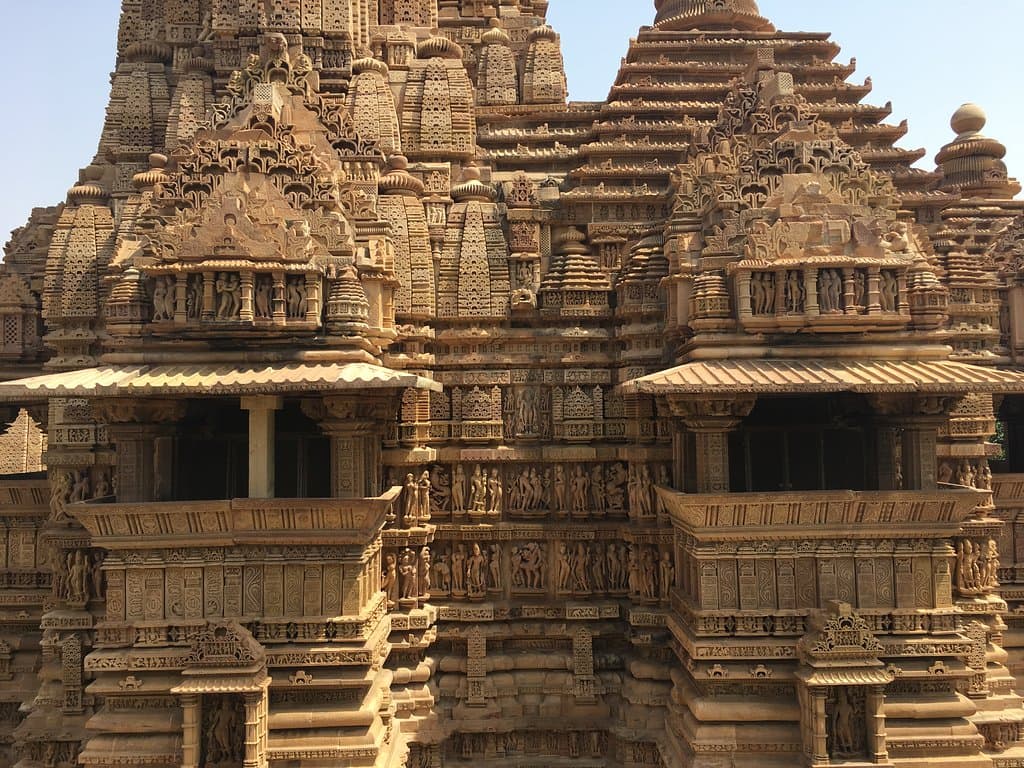Eastern Group Hindu
Explore the Eastern Group of Hindu temples in Khajuraho, a UNESCO World Heritage site famed for its exquisite medieval architecture and intricate scul...
Highlights
Must-see attractions

Social
From TikTok & Reddit
Best Time
Pleasant weather for exploration
Eastern Group Hindu
Best Time
Pleasant weather for exploration
Highlights
Must-see attractions
Explore the Eastern Group of Hindu temples in Khajuraho, a UNESCO World Heritage site famed for its exquisite medieval architecture and intricate sculptures.
"The Khajuraho temples are true examples of striking architecture and diversity of temple forms."
Wear comfortable shoes
You'll be doing a lot of walking to explore the temple complex. :athletic_shoe:
Hire a local guide
Enhance your understanding of the history and intricate carvings. :man_detective:
Highlights
Discover the most iconic attractions and experiences
Kandariya Mahadeva Temple
Western Group (though often visited in conjunction with Eastern)
The largest and most ornate temple, showcasing exquisite carvings and a towering shikhara.
Chitragupta Temple
Eastern Group
Dedicated to the Sun God, Surya, this temple features a magnificent idol and detailed carvings.
Parshvanatha Temple
Eastern Group
A prominent Jain temple known for its beautiful sculptures and architectural details.
Ghantai Temple
Eastern Group
Distinctive for its pillars adorned with Jain symbols and intricate artwork.
Plans like a pro.
Thinks like you
Planning Your Visit
Timing Your Visit to Khajuraho
Understanding the Khajuraho Complex
Best Times
Insider Tips
from TikTok, Instagram & Reddit
Wear comfortable shoes
You'll be doing a lot of walking to explore the temple complex. :athletic_shoe:
Hire a local guide
Enhance your understanding of the history and intricate carvings. :man_detective:
Stay hydrated
Carry plenty of water, especially during warmer months. :droplet:
Capture the details
The sculptures are incredibly detailed; take your time to photograph them. :camerawithflash:
Tips
from all over the internet
Wear comfortable shoes
You'll be doing a lot of walking to explore the temple complex. :athletic_shoe:
Hire a local guide
Enhance your understanding of the history and intricate carvings. :man_detective:
Stay hydrated
Carry plenty of water, especially during warmer months. :droplet:
Capture the details
The sculptures are incredibly detailed; take your time to photograph them. :camerawithflash:
Book accommodation in advance
Especially during peak season, ensure your stay is sorted. :bed:
What Travellers Say
Reviews Summary
Visitors are consistently awestruck by the intricate artistry and architectural grandeur of the Eastern Group of Hindu temples in Khajuraho. The detailed sculptures and historical significance are major highlights. However, some find the midday heat challenging and suggest better signage for navigating the complex.
What People Like
What People Dislike
Frequently Asked Questions
🚇 🗺️ Getting There
Khajuraho is accessible by air, rail, and road. The nearest airport is Khajuraho Airport (HJR), with flights from major Indian cities. Khajuraho Railway Station (KURJ) connects to several cities. Roadways connectivity is decent, with buses and taxis available from nearby cities like Jhansi and Satna. The Eastern Group is a short drive from the main town.
Yes, the Eastern and Western Groups are relatively close. You can hire an auto-rickshaw or a taxi to travel between them. Many visitors explore both groups on the same day.
Yes, rented scooters are available in Khajuraho, offering a convenient way to explore the temple complexes and surrounding areas at your own pace.
Khajuraho experiences hot summers (April-June), monsoon rains (July-September), and pleasant winters (October-March). The best time to visit is during the cooler months.
Khajuraho is located about 3 hours by road to the east of Orchha, making it a feasible combination for a trip.
🎫 🎫 Tickets & Entry
Yes, there is an entry fee for the Khajuraho Group of Monuments, which includes the Eastern Group. Tickets can be purchased at the site.
The temples are generally open from sunrise to sunset. It's advisable to check the exact timings upon arrival, as they can vary slightly.
Typically, a single entry ticket covers access to the main temple complexes, including the Eastern and Western Groups.
Photography is usually allowed in the temple complexes, but tripods and professional video recording might require special permission or incur additional fees.
Exploring all the temples within the Khajuraho complex, including the Eastern and Western Groups, is feasible in one day, especially if you start early. Raneh Falls is a separate excursion.
🎫 🏛️ Onsite Experience
Key temples in the Eastern Group include the Chitragupta Temple, Parshvanatha Temple, and Ghantai Temple, each offering unique architectural and sculptural marvels.
The intricate sculptures depict a wide range of subjects, from deities and celestial beings to scenes of daily life, warfare, and romantic pursuits, reflecting the diverse cultural and spiritual milieu of the era.
Yes, licensed local guides are available for hire at the temple sites. Hiring a guide can greatly enhance your understanding of the history and symbolism.
It's recommended to dress modestly out of respect for the religious sites. Comfortable clothing and footwear are essential for exploring the extensive temple grounds.
Basic facilities like restrooms are usually available near the temple complexes. It's always a good idea to carry your own water bottle.
📸 📸 Photography
Early mornings and late afternoons offer the best light for photography, creating a warm, golden glow on the sandstone. The midday sun can be harsh.
Focus on the intricate carvings, the architectural details of the shikharas, and the play of light and shadow on the sandstone. The sculptures depicting dancers and musicians are particularly photogenic.
Drone usage is generally restricted in and around historical monuments in India. It's best to check with local authorities or the Archaeological Survey of India for specific regulations.
A versatile lens (like a 24-70mm) is useful for capturing both wide shots and details. A wide-angle lens can be great for the grand structures.
While general photography is allowed, flash photography might be prohibited inside certain areas to protect the ancient artwork. Always observe signage and guide instructions.
For Different Travelers
Tailored advice for your travel style
👨👩👧 Families with Kids
🏛️ History Buffs & Art Enthusiasts
📸 Photographers
Deep Dives
In-depth insights and expert knowledge
The Architectural Marvels of Khajuraho
The architectural style is a testament to the advanced engineering and aesthetic sensibilities of the time. The layout of the temples often follows a plan that includes a garbhagriha (sanctum sanctorum), mandapa (hall), and ardhamandapa (entrance porch). The detailed friezes and sculptures are not merely decorative; they often narrate stories from Hindu epics, depict celestial beings, and portray various aspects of human life, including the famous erotic sculptures that have garnered much attention.
Visitors are often struck by the sheer scale and the meticulous craftsmanship. The sandstone blocks are so precisely cut and fitted that they appear almost seamless. Exploring these temples offers a glimpse into the rich cultural, religious, and social fabric of ancient India, making them a UNESCO World Heritage site and a must-visit for history and art enthusiasts.
Decoding the Sculptures: Art and Symbolism
A significant aspect of the Khajuraho sculptures, particularly those found on the outer walls, includes erotic themes. These are often interpreted in various ways, ranging from representations of kama (desire) as a legitimate pursuit in life, to tantric practices, or even as a symbolic depiction of the union of the soul with the divine. The Tantric sex aspect, as mentioned in some discussions, suggests a deeper spiritual interpretation beyond the physical.
Beyond the erotic, the temples showcase scenes of daily life, warfare, royal processions, and mythical creatures. The precision with which these figures are rendered, capturing movement and emotion, is remarkable. Each sculpture tells a story, offering a window into the beliefs, values, and artistic prowess of the Chandela era.
The Spiritual and Cultural Significance
The presence of Jain temples within the Khajuraho complex, such as the Parshvanatha Temple, highlights the religious tolerance and syncretism prevalent during that era. This coexistence of Hindu and Jain traditions within the same architectural landscape is a unique aspect of Khajuraho's heritage.
Modern interpretations and discussions often touch upon the preservation of Sanatan Dharma and Hindu culture, with initiatives like distributing Bhagavad Gita and offering courses aimed at propagating these traditions. The enduring legacy of these temples continues to inspire and educate visitors about India's rich spiritual and cultural past.

Social
from TikTok, Instagram & Reddit